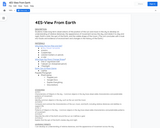
This video demonstrates the role of the sun on global warming.
- Subject:
- Earth Science
- Science
- Material Type:
- Lesson
- Provider:
- NASA
- Author:
- NASA
- Date Added:
- 02/26/2019

This video demonstrates the role of the sun on global warming.

In this article, teachers find two unit plans (grades K-2 and 3-5) that use resources featured in the science and literacy articles in the magazine. The unit plans are modeled after the five key steps in the learning cycle: engage, explore, explain, expand, and assess, or evaluate. The plans are aligned with the science content standards of the National Science Education Standards and the English language arts standards of the National Council of Teachers of English and the International Reading Association. The plans appear in the free, online magazine Beyond Weather and the Water Cycle.

This article discusses the strategy of using discrepant events in elementary science instruction. It includes links to four video clips of the sun's path in the Arctic or Antarctica.

Students will learn about the position of the sun and moon in the sky to develop an understanding of relative distances, the appearance of movement across the sky, and relate it to day and night, Earth's orbit, the spin of the Earth, and the visible shape of the moon.

In this lesson, students will take a closer look at the sun and begin to recognize its critical function in heating and warming the air, land, and water that sustain our lives. This will involve drawing their attention to the basics of the heat around them and how the sun is the primary source of that warmth. They will then perform a number of indoor and outdoor activities that support the benchmark, and help to begin their identification of the sun as the natural, universal source of heat in the world.

In this video, a meteorologist talks about the GOES satellite, which monitors solar activity.

This formative assessment item is used to uncover student ideas about solar radiation. Students will decide what they believe the sun provides to Earth. It is aligned to National Science Education Standards. Resources are provided to give additional information, as well as instructional suggestions.

This classroom activity helps students understand how the angle of the Sun affects temperatures around the globe. After experimenting with a heat lamp and thermometers at differing angles, students apply what they learned to explain temperature variations on Earth. The printable six-page handout includes a series of inquiry-based questions to get students thinking about what they already know about temperature patterns, detailed experiment directions and a worksheet that helps students use the experiment results to gain a deeper understanding of seasonal temperature changes and why Antarctica is always so cold.

This encyclopedia entry is for the term "eclipse." Text for this entry is appropriate for the middle and high school grade levels.